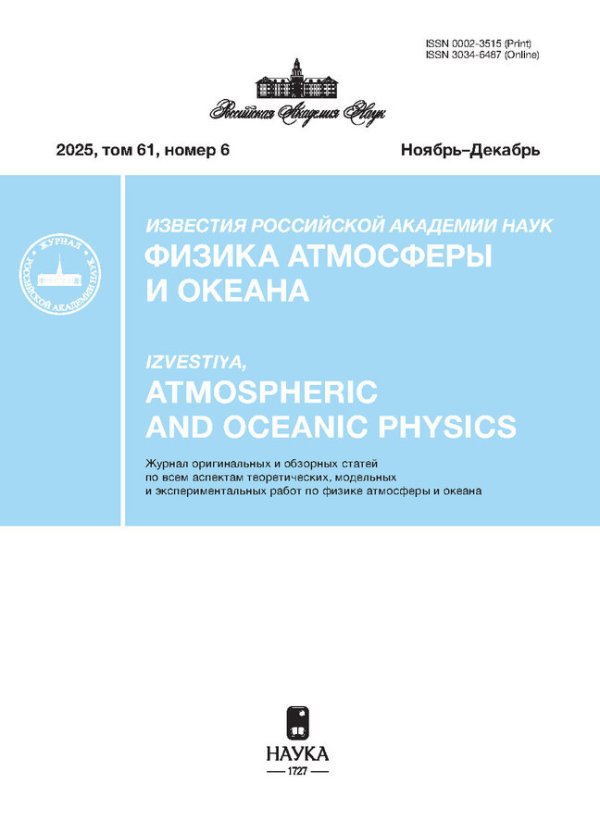Baroclinic Model of Jupiter’s Great Red Spot
- Authors: Suetin B.P.1, Zhmur V.V.1,2, Chkhetiani O.G.3
-
Affiliations:
- Moscow Institute of Physics and Techology
- Shirshoov Institute of Oceanology, Russian Academy of Sciences
- Obukhov Institute of Atmospheric Physics, Russian Acacdemy of Sciences
- Issue: Vol 59, No 3 (2023)
- Pages: 286-298
- Section: Articles
- URL: https://journals.rcsi.science/0002-3515/article/view/136909
- DOI: https://doi.org/10.31857/S0002351523030082
- EDN: https://elibrary.ru/TSBZJT
- ID: 136909
Cite item
Full Text
Abstract
The paper proposes a quasi-geostrophic baroclinic model of Jupiter’s Great Red Spot as a localized eddy formation in a continuously stratified rotating atmosphere under the action of a horizontal shear flow in the f-plane approximation. On the basis of the theory of ellipsoidal vortices, an analytical relationship is obtained between the geometric dimensions of the vortex, the potential vorticity of the vortex core, and the characteristics of the background flow. Measurements of a number of characteristics of both the vortex and the background current in the Voyager 1 (1979), Galileo (1996), and Cassini (2000) missions were used. Based on the theory, the vertical size of the Jupiter’s Great Red Spot was calculated, which turned out to be close to the same characteristic measured in the Voyager 1 (1979) mission. Based on the theory, an e-stimate of the vertical size of the Great Red Spot of Jupiter was obtained, which is consistent with the e-xperimental data of the Voyager 1 mission (1979).
About the authors
B. P. Suetin
Moscow Institute of Physics and Techology
Email: zhmur-vladimir@mail.ru
Russia, 141701, Moscow Region, Dolgoprudny, Institutskiy per., 9
V. V. Zhmur
Moscow Institute of Physics and Techology; Shirshoov Institute of Oceanology, Russian Academy of Sciences
Author for correspondence.
Email: zhmur-vladimir@mail.ru
Russia, 141701, Moscow Region, Dolgoprudny, Institutskiy per., 9; Russia, 117997, Moscow, Nakhimovskiy prosp., 36
O. G. Chkhetiani
Obukhov Institute of Atmospheric Physics, Russian Acacdemy of Sciences
Email: zhmur-vladimir@mail.ru
Russia, 119017, Moscow, Pyzhevsky per., 3
References
- Антипов С.В., Незлин М.В., Снежкин Е.Н., Трубников А.С. Автосолитон Россби и лабораторная модель Большого Красного пятна Юпитера // ЖЭТФ. 1985. Т. 89. Вып. 6. С. 1905–1920.
- Волокитин А.С., Красносельских В.В. Вихрь Россби как модель Большого Красного пятна Юпитера // Докл. АН СССР. 1981. Т. 260. 3. С. 588–591.
- Джалилиан П., Лю Т. Аналитическое решение для крупномасштабного вращающегося слоя жидкости с тепловой конвекцией XXI Известия РАН. Механика жидкости и газа. 2019. Т. 6. С. 3–11.
- Жмур В.В. Мезомасштабные вихри океана. М.: ГЕОС, 2011. 384 с.
- Жмур В.В., Панкратов К.К. Динамика эллипсоидального приповерхностного вихря в неоднородном потоке // Океанология. 1989. Т. 29. № 2. С. 205–211.
- Келлер В.С., Яворская И.М. Моделирование гидродинамических процессов в атмосферах больших планет // Аэромеханика и газовая динамика. М.: Наука, 1976. С. 256–279.
- Кирхгоф Г. Механика. Лекции по математической физике. М.: АН СССР, 1962. Пер. с нем.: Kirchhoff G. Vorlesungen uber ¨ mathematische Physik. Mechanik, Leipzig, 1874.
- Ларичев В.Д., Резник Г.М. О двумерных уединенных волнах Россби // Докл. АН СССР. 1976. Т. 231. № 5. С. 1077–1079.
- Незлин М.В. Бароклинная модификация баротропной модели Большого Красного пятна Юпитера // Письма в ЖЭТФ. 1981. Т. 34. Вып. 2. С. 83–86.
- Петвиашвили В.И. Красное пятно Юпитера и дрейфовый солитон в плазме // Письма в ЖЭТФ. 1980. Т. 32. Вып. 11. С. 632–635.
- Романова H.H., Цейтлин В.Ю. О квазигеострофических движениях в баротропной и бароклинной жидкости // Изв. АН СССР. Физика атмосферы и океана. 1984. Т. 20. № 2. С. 15–124.
- Романова H.H., Цейтлин В.Ю. Уединенные волны Россби в слабостратифицированной среде // Изв. АН СССР. Физика атмосферы и океана. 1985. Т. 21. № 8. С. 810–815.
- Сагдеев Р.З., Шапиро В.Д., Шевченко В.И. Большое красное пятно как синоптический вихрь в юпитерианской атмосфере // Письма в астрон. журн. 1981. Т. 7. Вып. 8. С. 505–509.
- Тихомолов Е.М. Поддержание вихревых структур в подогреваемом снизу вращающемся слое жидкости // Письма в ЖЭТФ. 1994. Т. 59. Вып. 3. С. 155–158.
- Чаплыгин С.А. Собрание сочинений. Т. 2. М.: Гостехиздат, 1948. 643 с.
- Шулейкин В.В. Плоские вихри с эллиптическим ядром на Юпитере (Большое Красное пятно) и на Земле // Астрон. журн. 1976. Т. 20. 4. С. 850–859.
- Beaumont D.N. Solitary waves on an unsymmetrical shear flow with applications to Jupiter’s Great Red Spot // Icarus. 1980. V. 41. 3. P. 400–409.
- Bolton S.J., Levin S.M., Guillot T., Li C., Kaspi Y., Orton G., Wong M.H., Oyafuso F., Allison M., Arballo J., Atreya S. Microwave observations reveal the deep extent and structure of Jupiter’s atmospheric vortices // Science. 2021. V. 374. Iss. 6570. P. 968–972.
- Bouchet F., Sommeria J. Emergence of intense jets and Jupiter’s Great Red Spot as maximum–entropy structures // J. Fluid Mech. 2002. V. 464, P. 165–207.
- Busse F.H. A simple model of convection in the Jovian atmosphere // Icarus. 1976. V. 29. № 2. P. 255–260.
- Busse F.H. Convection driven zonal flows and vortices in the major planets. Chaos. 1994. V. 4. № 2. P. 123–134.
- Chavanis P.H. Statistical mechanics of geophysical turbulence: application to Jovian flows and Jupiter’s Great Red Spot // Physica D. 2005. V. 200. Iss. 3–4. P. 257–272.
- Choi D.S., Banfield D. Velocity and vorticity measurements of Jupiter’s Great Red Spot using automated cloud feature tracking // Icarus. 2007. V. 188. № 1. P. 35–46.
- Dowling T.E., Ingersoll A.P. Jupiter’s Great Red Spot as a shallow water system // J. Atm. Sci. 1989. V. 46. Iss. 21. P. 3256–3278.
- Flierl G.R. Baroclinic solitary waves with radial symmetry // Dynamics of Atmospheres and Oceans. 1979. V. 3. № 1. P. 15–38.
- Williams G.R., Morrison P.J. Vilasur Swaminathan R. // Jovian vortices and jets. 2019. Fluids. V. 4. № 2. P. 104.
- Golitsyn G.S. A similarity approach to the general circulation of planetary atmospheres // Icarus. 1970. V. 13. № 1. P. 1–24.
- Heimpel M.H., Yadav R.K., Featherstone N.A., Aurnou J.M. Polar and mid–latitude vortices and zonal flows on Jupiter and Saturn // Icarus. 2022. V. 379. Iss. 6. P. 114 942.
- Hide R. Origin of Jupiter’s Great Red Spot // Nature. 1961. V. 190. Iss. 4779. P. 895–896.
- Ingersoll A.P. Inertial Taylor columns and Jupiter’s Great Red Spot // J. Atm. Sci. 1969 V. 26. Iss. 4 P. 744–752.
- Jones C.A., Kuzanyan K.M. Compressible convection in the deep atmospheres of giant planets // Icarus. 2009. V. 204(1). P. 227–238.
- Kaspi Y. Inferring the depth of the zonal jets on Jupiter and Saturn from odd gravity harmonics // Geophys. Res. Let. 2013. V. 40(4). P. 676–680.
- Kaspi Y., Galanti E., Hubbard W.B., Stevenson D.J., Bolton S.J., Iess L., Guillot T., Bloxham J., Connerney J.E.P., Cao H., Durante D. Jupiter’s atmospheric jet streams extend thousands of kilometres deep // Nature. 2018. V. 555. Iss. 7695. P. 223–226.
- Marcus P.S. Numerical simulation of Jupiter’s Great Red Spot // Nature. 1988. V. 331. Iss. 6158. P. 693–696.
- Marcus P.S., Lee C. 1994. Jupiter’s Great Red Spot and zonal winds as a self–consistent, one–layer, quasigeostrophic flow // Chaos. 1994. V. 4. № 2. P. 269–286.
- Maxworthy T., Redekopp L.G. New theory of the Great Red Spot from solitary waves in the Jovian atmosphere // Nature. 1976. V. 260. Iss. 5551. P. 509–511.
- Meacham S.P. Quasigeostrophical ellipsoidal vortices in stratified fluid // Dynamics of Atmospheres and Oceans. 1992. V. 16. № 3–4. P. 189–223.
- Michel J., Robert R. Statistical mechanical theory of the Great Red Spot of Jupiter // J. Stat. Phys. 1994. V. 77(3). P. 645–666.
- Miller J., Weichman P.B., Cross M.C. Statistical mechanics, Euler’s equation, and Jupiter’s Red Spot // Phys. Rev. A. 1992. V. 45(4). P. 2328–2359.
- Pankratov K.K., Zhmur V.V. A dynamics of desinglarized quasigeostrophic vortices // Phys. Fluids A. 1991. V. 3. P. 1464.
- Parisi M., Kaspi Y., Galanti E., Durante D., Bolton S.J., Levin S.M., Buccino D.R., Fletcher, L.N., Folkner W.M., Guillot T., Helled R. The depth of Jupiter’s Great Red Spot constrained by Juno gravity overflights // Science. 2021. V. 374. Iss. 6570. P. 964–968.
- Read P.L., Gierasch P.J. Mapping potential–vorticity dynamics on Jupiter. II: the Great Red Spot from Voyager 1 and 2 data // Q.J.R. Meteorol. Soc. 2006. V. 132. P. 1605–1625.
- Sagan C. A Truth Table Analysis of Models of Jupiter’s Great Red Spot // Comments Astrophys. Space Phys. 1971. V. 3. P. 65–72.
- Shetty S., Marcus P.S. Changes in Jupiter’s Great Red Spot (1979–2006) and Oval BA (2000–2006) // Icarus. 2010. V. 210. № 1. P. 182–201.
- Simon A.A., Tabataba–Vakili F., Cosentino R., Beebe R.F., Wong M.H., Orton, G.S. Historical and contemporary trends in the size, drift, and color of Jupiter’s Great Red Spot // Astron. J. 2018. V. 155. № 4. P. 151.
- Smoluchowski R. Jupiter’s convection and its red spot // Science. 1970. V. 168. Iss. 3937. P. 1340–1342.
- Sommeria J., Meyers S.D., Swinney H.L. Laboratory simulation of Jupiter’s great red spot // Nature. 1988. V. 331. Iss. 6158. P. 689–693.
- Williams G.P., 1979. Ultra–long baroclinic waves and Jupiter’s Great Red Spot // J. Meteorol. Soc. Jpn. Ser. II. 1979. V. 57(2). P. 196–198.
- Williams, G.P. 1985. Jovian and Comparative Atmospheric Modeling // In Advances in Geophysics. V. 28. P. 381–429. Elsevier.
- Williams G.P. 2003. Jet sets // J. Meteorol. Soc. Jpn. Ser. II. V. 81(3). P. 439–476.
- Wong M.H., Marcus P.S., Simon A.A., de Pater I., Tollefson J.W., Asay–Davis X. Evolution of the horizontal winds in Jupiter’s Great Red Spot from one Jovian year of HST/WFC3 maps // Geophys. Res. Let. 2021. V. 48(18). P. e2021GL093982.
- Yadav R.K., Heimpel M., Bloxham J. Deep convection–driven vortex formation on Jupiter and Saturn // 2020. Sci. Advances. 2020. V. 6(46). P. eabb9298.
- Yavorskaya I.M., Belyaev Y.N. On a convective model of Jupiter // Acta Astronaut. 1982. V. 9(6–7). P. 481–486.













